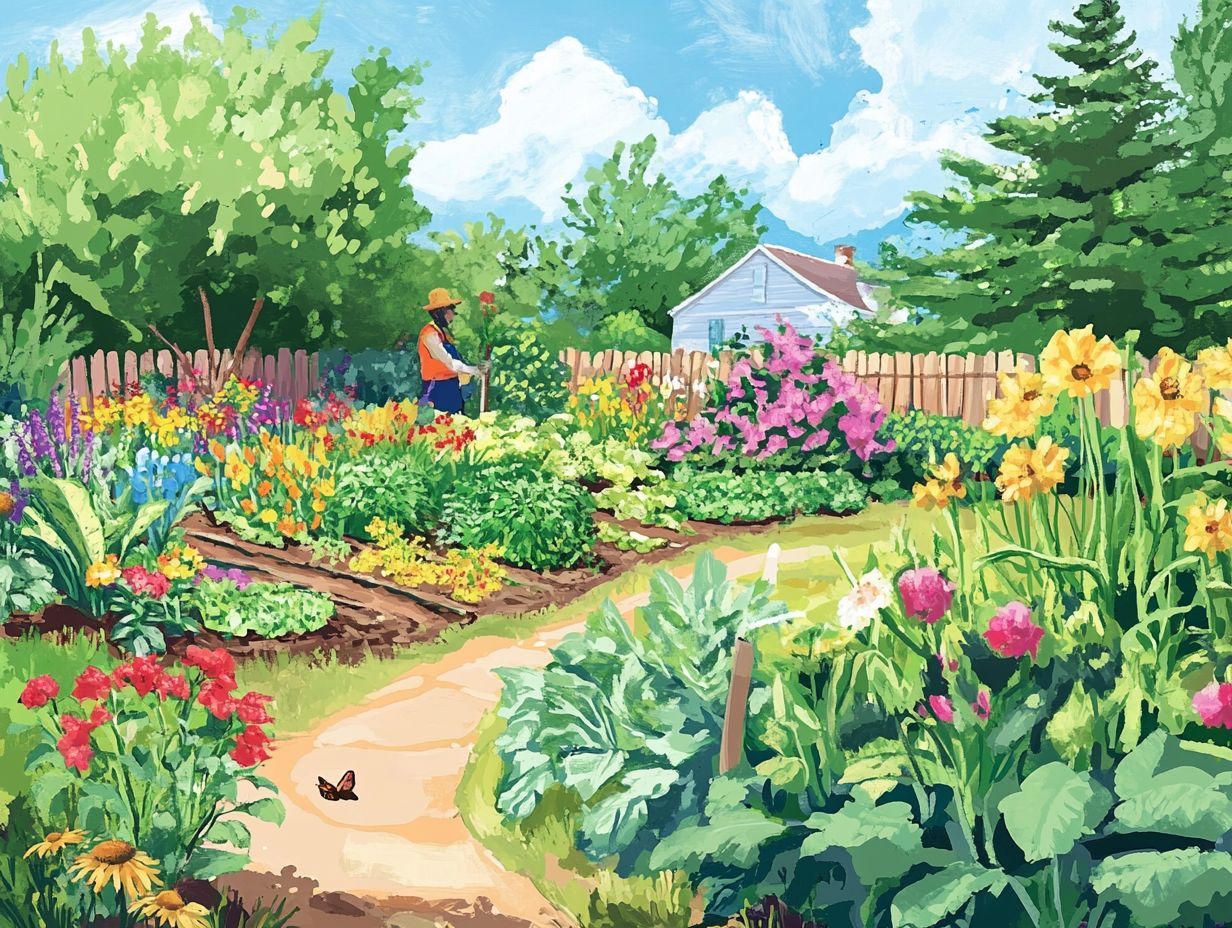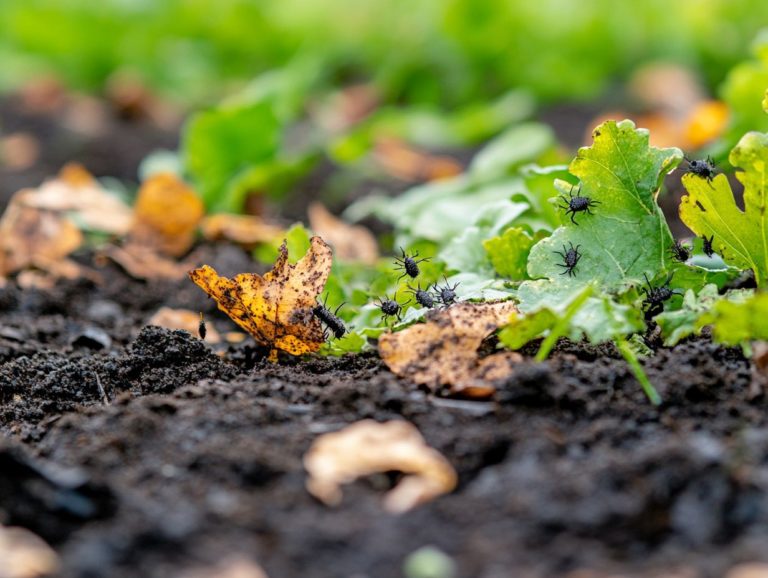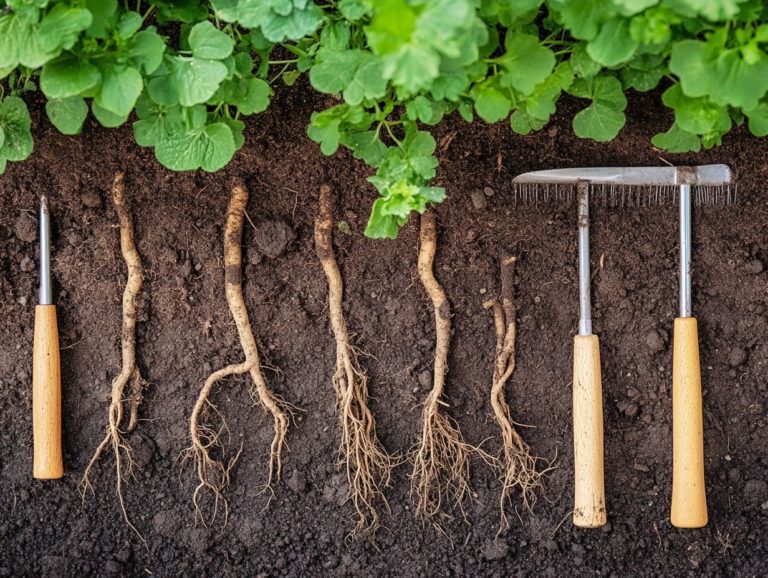The Benefits of Using Companion Plants
Companion planting is a gardening technique that plays on the relationships between different plants. By choosing the right pairings, you can improve pest control, enhance soil health, and boost your crop production.
Get ready to explore the amazing benefits of companion planting! This guide will help you pick the best plants for your garden and design a layout that maximizes space.
Are you prepared to cultivate a flourishing garden? Let’s dive into the world of companion plants and discover exciting growing combinations!
Contents
- Key Takeaways:
- The Benefits of Companion Planting
- Choosing the Right Companion Plants
- Creating a Companion Planting Plan
- Common Companion Plant Combinations
- Frequently Asked Questions
- What makes companion plants so special and how do they help your garden thrive?
- What are some examples of companion plants?
- How do companion plants help control pests?
- Can companion plants improve soil health?
- Do companion plants only benefit vegetable gardens?
- How can I plan a successful companion planting garden?
Key Takeaways:

What are Companion Plants?
Companion plants are your garden allies pairings that help each other grow better. This technique, called companion planting, enhances crop yields and fosters positive relationships between plants.
By selecting compatible species, you can create an environment where plants support each other. Some repel pests, while others help the soil absorb nutrients, making for a thriving ecosystem.
This method not only conserves space but also strengthens your plants against diseases. Enjoy a beautiful garden that showcases the amazing connections in nature!
The Benefits of Companion Planting
Companion planting offers many advantages to elevate your gardening experience. It helps maximize yields, enhance soil health, and provide effective pest control.
Embracing diversity in your garden supports vibrant ecosystems that enhance both the beauty and sustainability of your space.
Natural Pest Control
Natural pest control is a key benefit of companion planting. By choosing specific plants, you can repel pests while attracting helpful insects that reduce damage in your garden.
Take marigolds, for instance they deter nematodes and attract pollinators like bees. Planting basil alongside tomatoes not only enhances the flavor but also repels aphids and whiteflies.
Using these natural strategies helps limit harmful insects and promotes a balanced ecosystem. This approach protects your plants and nurtures soil health, ensuring your garden thrives organically.
This holistic technique encourages plant diversity and creates a lively habitat for beneficial insects, maintaining a vibrant cycle of life in your garden.
Improved Soil Health

Improved soil health stands out as a significant advantage of companion planting. The right plant pairings enhance soil resources and foster nutrient cycling.
Incorporate nitrogen fixers and cover crops. This will enrich your soil and support ongoing crop production.
Nitrogen-fixing plants, like legumes, are particularly valuable. They convert atmospheric nitrogen into a usable form for other plants, boosting soil fertility and reducing reliance on synthetic fertilizers.
Integrating cover crops is crucial. They help prevent erosion, suppress weeds, and enhance the organic matter content of your soil.
Different plant root structures collaborate effectively to break up compacted soil, improve aeration, and promote water infiltration.
Together, these practices create a healthy garden environment, setting the stage for robust plant growth while maintaining the delicate balance of soil health.
Increased Crop Yields
Increased crop yields are one of the standout benefits of companion planting. Specific combinations of plants create positive interactions that significantly boost agricultural productivity.
Optimize your plant pairings to experience remarkable improvements in both crop production and efficiency.
This technique harnesses the relationships between diverse plants, fostering an ecosystem that benefits every participant.
For instance, the classic pairing of tomatoes and basil not only maximizes garden space but also repels pests and enhances flavor.
The synergy in the traditional trio of corn, beans, and squash known as the Three Sisters demonstrates how strategic planting can improve nutrient cycling and shading, leading to higher yields.
Understanding the roles of companion plants, such as nitrogen fixers and pest deterrents, can unlock the potential for thriving gardens and bountiful harvests.
Choosing the Right Companion Plants
Choosing the right companion plants can transform your garden into a thriving paradise! By selecting compatible plants, you ensure an effective gardening technique while minimizing potential issues from poor plant pairings.
Grasping the intricacies of plant support systems and interaction dynamics is fundamental to cultivating a thriving garden ecosystem.
Factors to Consider
When selecting companion plants, consider important factors such as compatibility of plant pairings, nature of crop interactions, and the benefits that biodiversity brings to your garden.
These considerations will ensure your plants thrive together and contribute to their mutual growth.
Understanding how specific plants can repel pests or attract beneficial insects can significantly enhance the overall health of your garden.
For example, combining aromatic herbs with vegetables diversifies your garden and can elevate flavor and resilience.
Pay attention to the timing of planting, growth habits, and nutrient needs as these elements are crucial for creating harmonious ecosystems.
Nurture these relationships to cultivate an environment where your plants support each other’s growth, leading to a more productive and vibrant garden overall.
Creating a Companion Planting Plan

Creating a companion planting plan is vital for reaping the full rewards of companion planting, particularly for vegetable crops and effective interplanting strategies.
A carefully crafted layout can optimize both space and resources, ensuring each plant flourishes and effectively supports its companions.
Designing a Successful Layout
Designing a successful layout for companion planting means engaging in thoughtful plant pairing that maximizes your space while making your garden look beautiful. By strategically positioning plants, you can craft visually stunning and productive garden areas that make the most of the strengths inherent in companion plants.
This approach goes beyond looks; it fosters healthy growth through natural pest control and nutrient enhancement, creating a beautiful and lively garden that’s a joy to see! By taking into account factors such as plant height, color, and growth patterns, you can layer your plants in a way that enhances both their productivity and visual appeal.
For example, taller plants can provide essential shade for shorter varieties, while vibrant flowers can draw in beneficial pollinators.
A well-planned layout ensures that each plant complements the others, resulting in an inspiring garden that captivates the eye and promotes biodiversity.
Common Companion Plant Combinations
Consider the benefits of common companion plant combinations, which illustrate how specific crop pairings can significantly enhance the health and productivity of your garden, including the best companion plants for pest control.
Many of these combinations incorporate aromatic herbs and trap crops, providing additional advantages. These thoughtful pairings highlight the power of strategic planning in optimizing plant interactions and improving pest control.
Examples and Benefits
Examples and benefits of companion plants are abundant, with marigolds, beans, corn, and squash showcasing powerful combinations that elevate your crop production and overall health. These plants work together to support each other through beneficial interactions while enhancing soil vitality and pest management.
When you plant marigolds alongside vegetables such as beans, corn, and squash, they release natural compounds that repel harmful insects, creating a thriving garden ecosystem. For instance, marigolds have a knack for keeping nematodes and aphids at bay, protecting your precious crops. Meanwhile, the nitrogen-fixing properties of beans, which means they help to put nutrients back into the soil, enrich the soil and establish a nutrient-rich haven where corn and squash can flourish.
This synergistic relationship not only results in higher yields but also fosters diversity within the soil microbiome, bolstering overall resilience. By understanding and harnessing these companion plant pairings, you can cultivate a healthier and more productive garden while minimizing your reliance on chemical pesticides.
Frequently Asked Questions

What makes companion plants so special and how do they help your garden thrive?
Companion plants are plants that are grown together for the mutual benefits they provide. They can help control pests, improve soil health, and increase crop yield.
What are some examples of companion plants?
Some common companion plants include marigolds, basil, and borage. Marigolds can repel pests, basil can improve the flavor of tomatoes, and borage can attract pollinators.
How do companion plants help control pests?
Companion plants can repel pests through their scent or by masking the scent of the crop. They can also attract beneficial insects that feed on pests.
Can companion plants improve soil health?
Yes, certain plants can help improve soil health by fixing nutrients in the soil, increasing microbial activity, and preventing erosion.
Do companion plants only benefit vegetable gardens?
No, companion plants can also benefit flower gardens and fruit orchards. They can attract pollinators, repel harmful insects, and provide shade and support for other plants.
How can I plan a successful companion planting garden?
Start by researching which plants have beneficial effects on each other. Consider factors such as planting location, sun exposure, and soil conditions. Also, rotate your companion plants each season to avoid depleting the soil of specific nutrients.
Start designing your thriving garden today with these amazing companion plant pairings!






